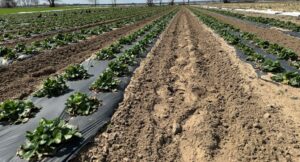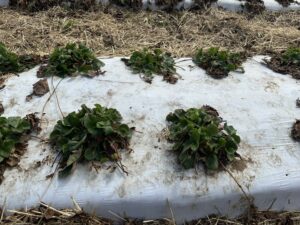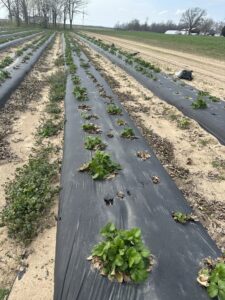Crop Status
Plug plants set on black plastic mulch in late summer and early fall are approaching full bloom. Some early blooms may have been damaged by recent low temperatures. Moving forward, growers should remain vigilant in protecting these crops from potential frost injury (Figure 1). Bare-root plants that were planted on white plastic during the summer and covered with straw are growing new leaves. Flower buds have not yet been observed on the main-season cultivars (Figure 2).

Figure 1. These plants are approaching bloom in southern Indiana.

Figure 2. These plants were covered with straw in the winter. Straw was removed around March 10. The plants are growing new leaves.
About Neopestalotiopsis
Plug plants infested with Neopestalotiopsis were found in Indiana. The infected plants exhibited stunted growth last fall, and some of the smaller plants did not survive the winter (Figure 3).

Figure 3. Neopestalotiopsis was confirmed in the field last fall, and some plants did not survive the winter.
The current questions are: for the surviving plants—especially those that appear healthy—are they worth saving? And what fungicide program can be used to protect adjacent, unaffected plants?
Over the winter, I’ve been consulting with plant pathologists to learn more. The pathogen appears to spread, and can persist in the field for extended periods. Fungicides including Switch, Thiram, and products in FRAC Group 3 have shown effectiveness. More information on managing Neopestalotiopsis, please check the following resources:
Natalia Peres, University of Florida, Strawberry disease season roundup: Neopestalotiopis, of course, but that is not all!
Nicole Gauthier, University of Kentucky, Neopestalotiopsis disease in Kentucky strawberry
A bit of good news: several cultivars with improved tolerance to Neopestalotiopsis will become available in the coming season. They are from Florida and California breeding programs. But I don’t yet have information on how they would perform under conditions in our region.